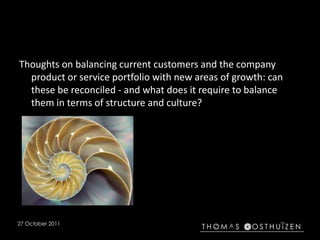
A view on brand portfolio management, innovation, profitability and corporate culture
- 1. 27 October 2011 Thoughts on balancing current customers and the company product or service portfolio with new areas of growth: can these be reconciled - and what does it require to balance them in terms of structure and culture?
- 2. Everything we do in marketing is to: • Attract more customers. • Retain existing customers with the right profile. • Grow the revenue of existing customers. • Grow the profit margin/ customer. • Grow the asset value of the business. This is a function of the number, value and profit margin of customers and the strength of the brand/ cost structure of the business. All the marketing metrics we put in place are diagnostic tools we use to understand why we are growing - or not growing - relative to the above objectives - and thereby align our operations with our strategy.
- 3. It is true that: • Outside of size, the only ways to achieve superior performance are: – By having a niche focus; – By creating exceptional products and services; – By being different enough so that consumers will pay for it; – By changing the competitive paradigm. • Whilst the first three makes a company competitive, the last one makes a company leapfrog competitors: • The top 20 companies in the Fortune 2010 list of fastest growing companies received $3,40 in incremental market capitalisation for every $1 of revenue growth. • For the companies that created new categories, this was $5,60!
- 4. Let us look at the traditional Ansoff matrix to balance growth: companies balance attracting new customers with launching new products and services. Market extension Market penetration Product development Diversification Markets Products Increasing technological new-ness Increasing market new-ness Aim to saturate the market (or all segments) Extend existing products to new markets and/ or segments Sell new products to existing markets (or segments) Sell new products to new markets (or segments)
- 5. Let us introduce category creation as a major new area of growth. This requires radical thinking, not easy to reconcile with traditional thinking and operations. Market extension Market penetration Product development Diversification Markets Products Increasing technological new-ness Increasing market new-ness Category creation Incremental innovation Sell new products to new markets and create new markets altogether Most companies try and manage existing customer and product/ service revenue with new revenue from new customers and products: the operational requirements for these are very different. It is unlikely they will both co-exist with ease.
- 6. Levels of profitability by type of innovation: if you compare where the exponential benefit to profitability is largest, it is within niche markets, products with regular incremental innovation and revolutionary new products or services. Degree of competitiveness Low – commoditised Highly differentiated Profitability Commoditised – most airlines Differentiated offers, i.e. better service Niche markets New categories Revolutionary new products High margin spaces Moderate to fair margin spaces Low margin spaces, only competitive advantage volume
- 7. Profitability growth should be exponential. If we compare Ansoff with what we learn about incremental profitability, we can hypothesize: Market extension Market penetration Product development Diversification Markets Products Increasing technological new-ness Increasing market new-ness Category creation Incremental innovation Exponential increases in profit margin: more customers at the same rate of profitability and resource utilization will increase revenue and the magnitude of profit, whilst incremental and radical innovation will lead to an exponential growth in profit margin.
- 8. One growth area focus on resource optimisation(processes & control), the other on brand value proposition optimisation(vision, innovation & collaboration). Market extension Market penetration Product development Diversification Markets Products Increasing technological new-ness Increasing market new-ness Category creation Incremental innovation Brand value proposition renewal Resource optimisation Better capacity utilisation: more customers at the same or a slightly higher cost-base. The same or more customers with incremental or radically different new products and services, at higher margins and most likely with increases in the cost structure of the company. In the instances of radical products, these will be new business units.
- 9. The different areas have different organisational requirements. It is important to acknowledge that and structure accordingly. This will also have cultural implications. Market extension Market penetration Product development Diversification Markets Products Increasing technological new-ness Increasing market new-ness Category creation Incremental innovation Greater collaboration & technocratic focus, less autocracy, a commitment to ongoing improvement Clear management structures, processes & controls; internal focus, even degree of autocracy Visionary leadership, networks of influencers and collaborators, collaborative management approach, working with small independents A lean operational “machine” produces standardised products and services using standardised structures, processes and trained staff. Deviation leads to inefficiencies and a breakdown in quality. Cost control imperative. Radical innovation requires new people & approaches. Traditional structures can kill such innovation. Often these needs to be in different companies. Incremental innovation requires adherence to the core customer and business
- 10. How do we balance current growth with potential growth? • Separate incremental innovation: making existing products better, with radical innovation: creating new categories. • The first one uses new technology to “update” features and benefits of products and services for consumers (i.e. a new Gillette razor blade). • The latter uses existing or new technology to design new categories. • These two areas are hardly ever able to sit side-by-side, the latter requires different ways of thinking and doing. That is why companies like P&G uses small companies to do this, or Apple uses applications designers that do not work for them. Verganti says that companies that are very successful at this use influencers and collaborators extensively. Consumer research using traditional approaches are not that useful here. • Incremental innovation is easier: it is updating existing products and services to make the delivery better for consumers. Here the secret is to be first, not second or last. Traditional consumer research is more useful here. • Generally, experiential and experimental research is great for radical innovation.
